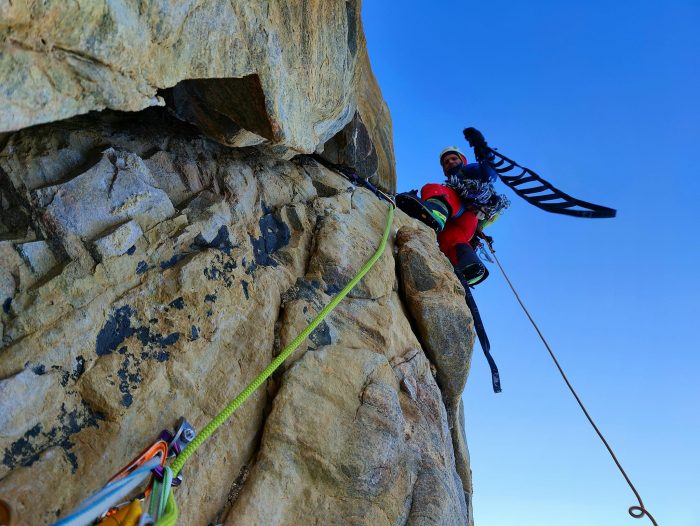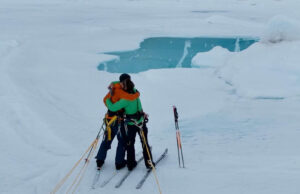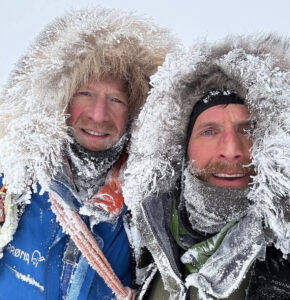Three weeks after arriving on Greenland’s west coast, Marcin Tomaszewski and Pawel Haldas completed an awesome new big-wall route near the town of Uummannaq.
At first, it looked like everything had gone smoothly. In fact, it was quite tricky. Here is their complete report, with some stunning images and video from their winter climb.

Belaying. Photo: Marcin Tomaszewski
Choosing a target
Tomaszewski and Haldas aimed for big walls on the Stor and Agpat Islands, near Uummannaq. To pick a climbing spot, they sought the advice of local hunters, who told them about some big cliffs they had passed during hunting expeditions.
“We wanted to get a close look at them. This was possible thanks to the snowmobiles and local fishermen’s knowledge of the current state of the ice cover,” the climbers wrote. “We saw plenty of interesting alpine-type massifs, a real climbing El Dorado, and above all, a beautiful exposed rock wall about six kilometers wide and of unknown height. The decision was made in silence, we fell in love with this piece of frozen rock.”

The wall. Photo: Marcin Tomaszewski
Getting started
On February 9, the pair pitched their tents on the ice, secured with ice screws. The following morning, they headed for the wall.
They did the climb in capsule style. First, they fixed the lower part of the wall in sunny but cold conditions. Temperatures dropped to -40ºC, a particularly frigid spell for the region, according to locals. And so the first stage of the climb was mainly a fight against the cold.
They managed to fix a section of the wall and set up a portaledge.
“Climbing the lower part of the wall was not technically difficult but was very demanding because of loose rock…Black bands of rock enveloping the wall at two levels meant poorer quality granite and a high risk of spontaneously falling fragments. The short seven-hour day meant that we were unable to complete more than one or two pitches a day, either by aid climbing or free climbing up to M5.”
Climbing at night was out of the question. At that latitude in mid-February, the sun is only up between 9 am and 3:30 pm. Nights are long and dark and even colder than the days. Their priority was not to get frostbitten, so they stopped when the cold became unbearable, even if that meant slower progress.
“Every day we were on the verge of frostbite on our toes and hands. Now and then, we lost feeling and they turned white. A moment’s negligence would have ended our expedition and our dream of a new route on this beautiful wall.”

Battling the cold on the lower part of the face. Photo: Marcin Tomaszewski
Their chosen line was crystal clear to the climbers.
“As it turned out, the only last-minute change [of direction] came at the top where we had a choice between two big exit corners.”
Both options looked too brittle and loose, but they found a stripe of orange rock in the middle and took that. It was the best choice.

Setting off from the portaledge bivouac. Photo: Marcin Tomaszewski
The final push
“On February 18, we set off for the wall for good. We deliberately avoided bivouacking lower down the face because of falling rocks,” Tomaszewski wrote. Instead, they hauled their equipment up to the portaledge, installed above the ninth pitch. From there, they got started on the strict routine of big wall climbing.
“The cold is our biggest opponent. After a moment’s rest, the body cools down, cutting the heat from our fingers, which then requires warming them up again and again. There must always be time for this! We take turns leading each day. One wears light clothes and moves all day, while the belayer wears his warmest down clothes to survive a day on the wall.

A tricky passage. Photo: Marcin Tomaszewski
“During the climb, we go through several chimneys and overhangs that are too wide for our six cams, forcing us to do some real acrobatics and reach for the black magic of climbing. After passing the second visible strip of black rock, Pawel [Haldas] pushes on to the demanding A3 pitch. I can hear the rumbling flakes and see thin slabs stuck to the wall, and I am standing directly underneath them! I feel like a condemned man under the guillotine.

During the climb. Photo: Pawel Haldas
“So we decided to use some bat hooks to reach safer formations. This pitch took Pawel a good couple of hours in silence. He climbed in terrible wind and spindrift. He was extremely brave, I was proud of him. Thanks to this progress…we had the chance to climb to the summit the next day, on the last day of good weather.”

The sea ice and the tiny tents far below. Photo: Marcin Tomaszewski
Summit day
“We woke up at 5 am to an amazing day, a real reward: windless and seemingly warmer than usual. I sped off and led two long, exposed A1/C1 pitches to the top of the wall. It was beautiful! On leaving the wall, we untied ourselves, and after another few dozen meters, we stood at the summit.”
“The icebergs below us trapped in the frozen fiord looked insane…It’s hard to describe what we felt, what we saw. This moment was composed of many brief moments from the past days, months, and life. It is impossible to describe.”

Reflections from the portaledge. Photo: Marcin Tomaszewski
They named their new line Fram, after Fridtjof Nansen’s famous polar ship. The wall is locally known as Oqatssut, and the route’s details are as follows: 700m, 17 pitches, M5, A3, C2, VI Big Wall 10-24.02. It was, the climbers say, the first big wall winter climb in Greenland.

Topo and details of the new line. Photo: Marcin Tomaszewski
A rapid descent
The descent the following day from their bivouac site was a race against the weather. The forecast predicted 110kph winds. Luckily, the climbers made it back down at noon, just in time for an Inuit hunter they were dealing with to pick them up and drive them back to Uummannaq.
One hour later, “the ice cracked and began to turn into a thick soup. In the evening, the wind hit with full force. We can’t imagine what would have happened if we hadn’t made it.”

Photo: Marcin Tomaszewski
Tomaszewski said that over the following days, most of the ice around the walls of Stor Oen (Big Island) disappeared. Western Greenland gets a spur of warm water upwellings from the Gulf Stream, and changes can happen quickly.
“The thought kept running through my mind that a one-day delay might have resulted in us being cut off from the world for longer than we would have liked,” he said. “We were extremely lucky.”

Within 24 hours, solid sea ice became open water. Photo: Marcin Tomaszewski
As for Oqatssut, the climbers warn it is brittle and could prove quite risky in summer. “However, it is still worth examining it closely,” they added. “There are quite a few interesting places for new routes.”
There are more details and pictures on Tomaszewski’s Facebook page.






